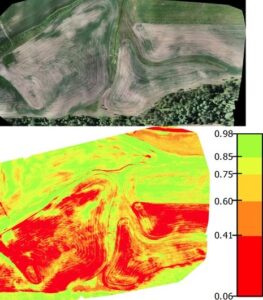
For pesticides to be most effective, the applications need to be timely and based on a threshold. Integrated pest management (IPM) promotes the use of a combination of management tactics allowing a biorational use of pesticides according to decision-making guidelines; early detection and identification of stress factors are two of the most important components in the decision-making process.
Recent technological advances in imaging sensors have made it possible to remotely detect pest-specific changes in plant phenotype and physiology. However, changes in response to pest damage within host plant species may differ, for example, because of the differences in genotype (e.g., cultivar) susceptibility to a pest. We work to identify spectral signatures associated with pest damage and determine whether the detected wavelengths vary across the cultivars. An effective monitoring tool will enable us to take additional necessary actions to mitigate losses more effectively and in a timely manner.